Hello there, décor lovers!
We’re delving into the realm of “Coffered Ceilings” today, a style of architecture that has long added a touch of luxury to homes. You’ve come to the perfect place if you’re looking to give your room a touch of classic elegance.
Table of Contents
Coffered ceilings, often referred to as “sunken panels”, are a series of geometrically shaped recesses in a ceiling, framed with beams. They are the perfect blend of old-world charm and modern sophistication, providing depth and interest to any room. The coffered ceiling design dates back to ancient Greece and Rome, and yet, it never seems to go out of style.
Regardless of whether you’re renovating an older home or designing a new one, coffered ceilings can seamlessly blend with a variety of architectural styles. They not only enhance the aesthetics of your room but can also improve acoustics and increase the perceived height of a space.
Throughout this post, we’ll discuss everything you need to know about coffered ceilings, from their history and types to the process of installation and upkeep. By the end, you’ll be brimming with inspiration and practical knowledge on how to incorporate this timeless feature into your home.
Stay tuned, and let’s embark on this exciting journey of ceiling design together!
What is a Coffer?

A “coffer” – sounds pretty fancy, doesn’t it? Well, in the world of architecture and design, it indeed is! Derived from the Latin word ‘cophinus’, which means basket, a coffer in architectural terms is a hollowed-out or sunken panel. When we’re talking about ceilings, these are those delightful square, rectangular, or even octagonal indentations you often see, creating a pattern of repeating sunken panels.
Originally used in ancient Greek and Roman architecture, coffers were employed as a method of reducing the weight of stone ceilings. Clever, isn’t it? Their function went beyond the practical, however, quickly evolving into an aesthetic feature symbolizing grandeur and sophistication.
In today’s interior design scene, a coffer refers to a decorative element incorporated into a ceiling’s structure. It’s all about creating that depth and dimension, lending a rich, textured look to your living space. But there’s more than just style to these architectural gems – coffers can also improve the acoustics of a room and make the ceiling appear higher.
So, in essence, a coffer is a unique blend of functionality and aesthetics, a beautiful contradiction of recess and prominence. Quite a charming paradox, isn’t it?
Exploring Waffle Ceilings
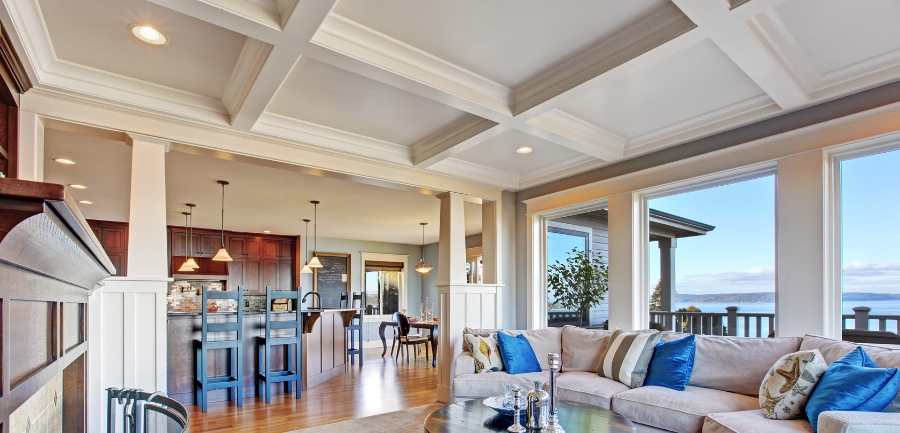
For lovers of architectural details, here’s another concept that’s sure to pique your interest – “Waffle Ceilings”. Now, before your mind veers towards breakfast, let’s clarify that a waffle ceiling, much like the culinary delight it shares a name with, is all about pattern and texture!
Waffle ceilings are a contemporary take on traditional coffered ceilings, distinguished by their smaller, more intricate grid-like pattern, resembling, well, a waffle. These sunken panels are generally square or rectangular, creating a consistent, repeating pattern that adds a tremendous amount of visual interest and depth to a room.
While coffered ceilings offer a classic, grand appearance, waffle ceilings have a more modern appeal, perfectly suited to contemporary and minimalist interiors. They bring in the same architectural sophistication and illusion of height that coffered ceilings offer but with a fresh, modern twist.
Furthermore, waffle ceilings allow for a high degree of customization. You can experiment with different sizes for the panels and beams, adjust the depth of the recesses, or even introduce colors or lighting within the design. If you’re seeking a stylish, custom look that’s sure to make a statement, waffle ceilings are definitely worth considering.
Coffered Ceiling Considerations

If you’re already in awe of coffered ceilings and are considering incorporating them into your space, there are several key aspects you need to take into account. Let’s dive into these considerations, shall we?
Firstly, the height of your ceiling is a crucial factor. Coffered ceilings work best in rooms with a high ceiling (at least nine feet), as they can make a lower ceiling feel even more confined. Remember, the primary appeal of coffered ceilings is their ability to create an illusion of increased height and spaciousness.
Secondly, consider the style and period of your home. While coffered ceilings can enhance a variety of architectural styles, it’s essential to ensure they blend seamlessly with your home’s overall aesthetic. A mismatch could result in a disjointed feel.
Budget is another important aspect. Coffered ceilings can be more costly than standard ceiling finishes due to the labor and materials involved. Keep in mind that the price will also vary depending on the complexity of the design and the type of materials used.
Lastly, maintenance should be factored into your decision. Coffered ceilings require more upkeep than flat ceilings, especially if they’re painted or finished with wood, which may require periodic touch-ups.
Remember, beauty, much like coffered ceilings, is more than skin deep – considering these factors will ensure your ceiling is as practical as it is beautiful!
How to Install a Coffered Ceiling
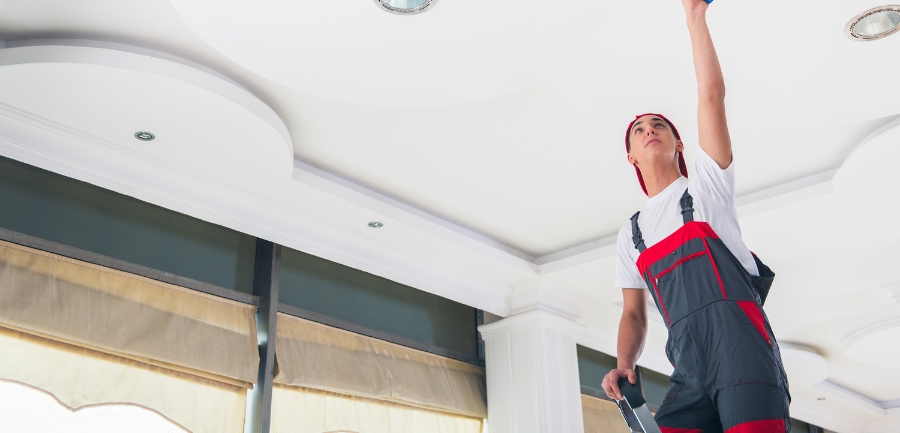
If you’re a handy DIYer, you might be excited at the prospect of installing your own coffered ceiling. While it’s certainly a project that requires some effort and patience, the end result can be incredibly rewarding. Let’s take a step-by-step look at how you can install a coffered ceiling.
Step 1: Planning & Design
Before starting, sketch your desired design on graph paper, factoring in the room’s dimensions. Keep in mind the number and size of the coffers. Also, consider the width and depth of your beams, which are crucial in achieving the desired look.
Step 2: Material Preparation
Once you have your design ready, calculate the number of materials needed, such as beam material (typically MDF, plywood, or solid wood), molding, nailers, and adhesive. Prepare all your tools as well, including a nail gun, saw, and level.
Step 3: Installation of Beams
Begin by installing the perimeter beams. Use a level to ensure they’re straight. Next, install the cross beams according to your design, ensuring they’re evenly spaced.
Step 4: Adding the Coffered Panels
You can then install the coffer panels after the beam framework is put in place. They ought to fit perfectly inside the beam framework.
Step 5: Finishing Touches
To finish, fill any nail holes and apply paint or stain to match your room’s décor.
This project certainly demands time, precision, and attention to detail. However, if you’re confident in your DIY skills, it can be a great way to create a bespoke ceiling that reflects your personal style. Do remember, though, if you’re unsure or uncomfortable taking on such a project, it’s always best to hire a professional. After all, the beauty of coffered ceilings lies in their precision and meticulous finish.
Types of Coffered Ceilings
The world of coffered ceilings is a rich and varied landscape, filled with a multitude of designs that cater to diverse tastes and styles. Let’s explore some popular types that could help transform your space.
- Traditional Coffered Ceilings: Reminiscent of classical architecture, these often feature large, square, or rectangular coffers with ornate moldings. They are a great fit for homes with a classic, luxurious decor theme.
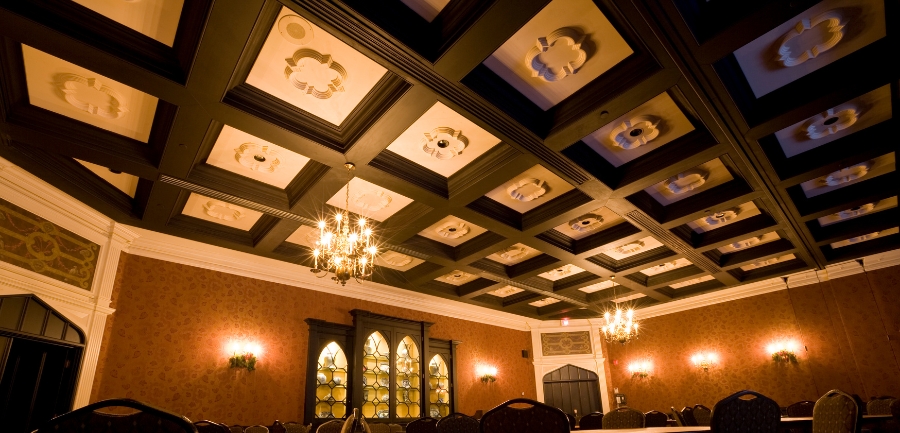
- Contemporary Coffered Ceilings: These have a minimalistic style with straight lines and straightforward moldings. They add a bit of refinement without being over the top when used in modern settings.

- Waffle Ceilings: A modern variant of the coffered ceiling, these feature a tighter grid pattern, resembling a waffle. They provide a unique, modern aesthetic and work great in both traditional and contemporary spaces.
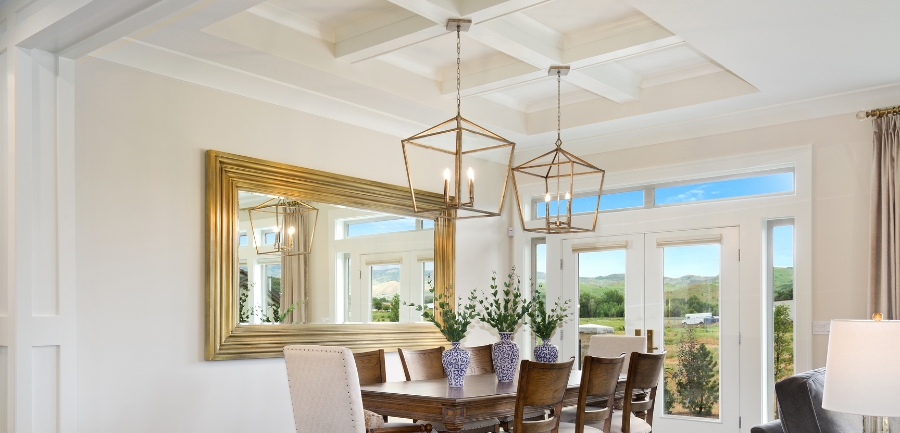
- Cathedral Coffered Ceilings: Best suited for rooms with a vaulted or cathedral ceiling, these coffered ceilings follow the ceiling’s curve, adding depth and visual interest to the space.

- Custom Coffered Ceilings: These are tailored to your specifications and can include elements from various styles to create a unique, personalized design.

Selecting the right type of coffered ceiling comes down to considering the architectural style of your home, the room’s function, and your personal aesthetic preference. Each type has its own charm and can significantly enhance the visual appeal of your space.
Unleashing Your Creativity with Coffered Ceilings
If you’re still seeking that spark of inspiration for your coffered ceiling project, look no further! Here, we’re going to explore some exciting and creative ideas for coffered ceilings. Each of these concepts offers a unique perspective, fueling your imagination and aiding you in creating your dream ceiling. Let’s dive in!
Wood Ceiling Ideas in the Kitchen
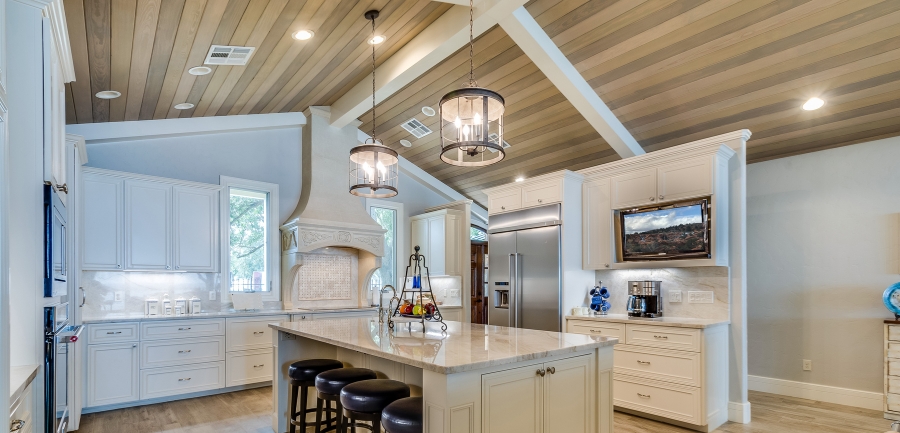
Think about an elegant kitchen space with wooden coffered ceilings. The warm, natural texture of the wood, paired with the intricate coffered design, can create a stunning centerpiece that exudes both coziness and luxury. Whether it’s rustic oak or polished mahogany, a wooden coffered ceiling can wonderfully complement your kitchen decor while adding a touch of refined charm.
Coffered Ceiling Ideas in the Bathroom
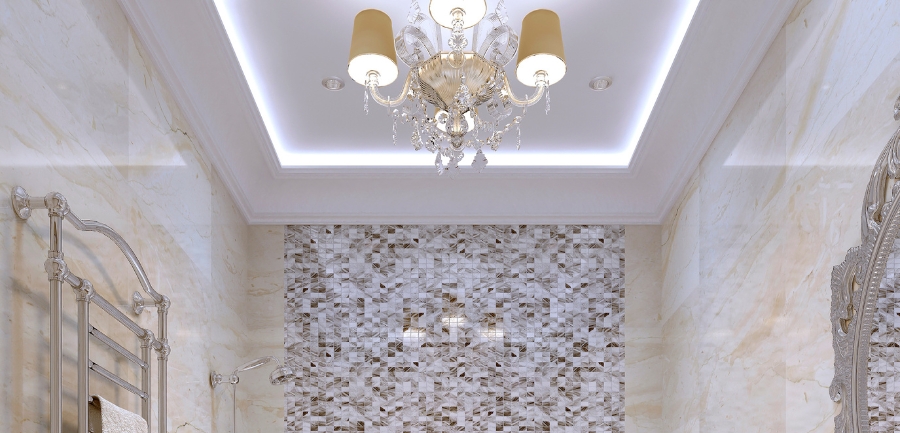
Picture your bathroom transformed into a sanctuary of elegance with a coffered ceiling. This feature can add depth and interest to what is often an overlooked space in terms of design. A white or pastel-colored coffered ceiling can brighten up the room, enhancing its tranquil, clean appeal. Additionally, you could integrate recessed lighting within the coffers for an added sense of luxury and comfort.
Tray Ceiling Ideas in the Master Bedroom
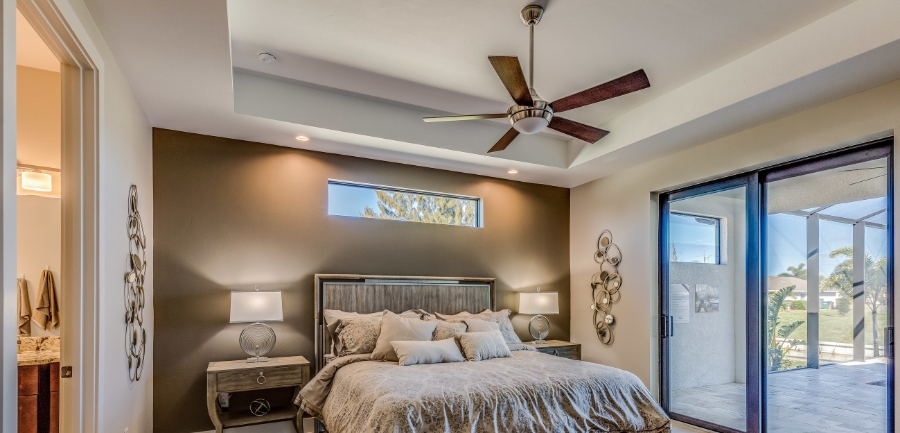
Envision a master bedroom graced with a tray-style coffered ceiling. This design can add an extra layer of depth and sophistication to your private retreat. The stepped or sloped edges of the tray design create a unique, tiered look that is both modern and elegant. To make it even more captivating, consider adding accent lighting or a bold paint color inside the tray – a perfect way to bring drama and warmth to your bedroom sanctuary.
Decorative Ceiling Beams Ideas in the Family Room
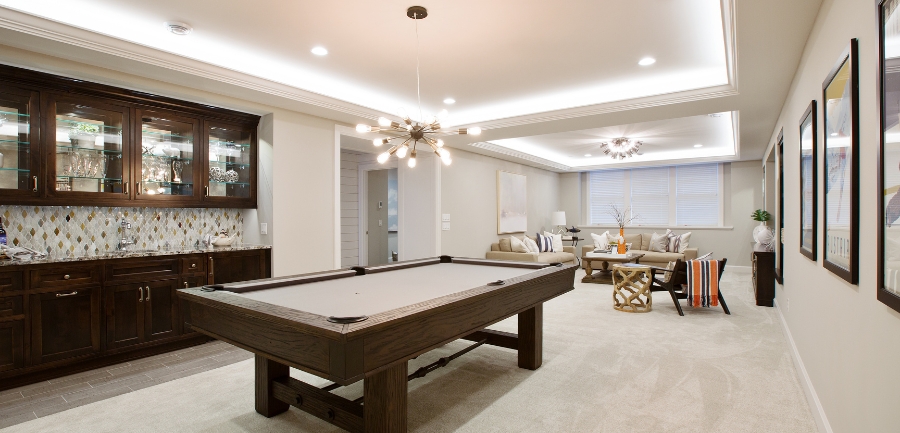
Picture your family room, the heart of your home, accentuated with decorative coffered ceilings featuring stylish ceiling beams. This architectural detail can add a distinctive charm, transforming your family room into an inviting, cozy space.
The design possibilities with decorative beams are endless. You could opt for a rustic look with rough-hewn or reclaimed wooden beams, perfect for country or cottage-style decor. If your family room follows a more modern or minimalist aesthetic, consider sleek, painted beams that add depth without overpowering the space.
In addition to their aesthetic appeal, these beams can also be functional. You can creatively use them to hide wiring for lighting fixtures or audio-visual equipment. With some thoughtful planning and design, decorative ceiling beams in your coffered ceiling can elevate your family room into a warm and inviting gathering space that beautifully blends form and function.
New Ceiling Design
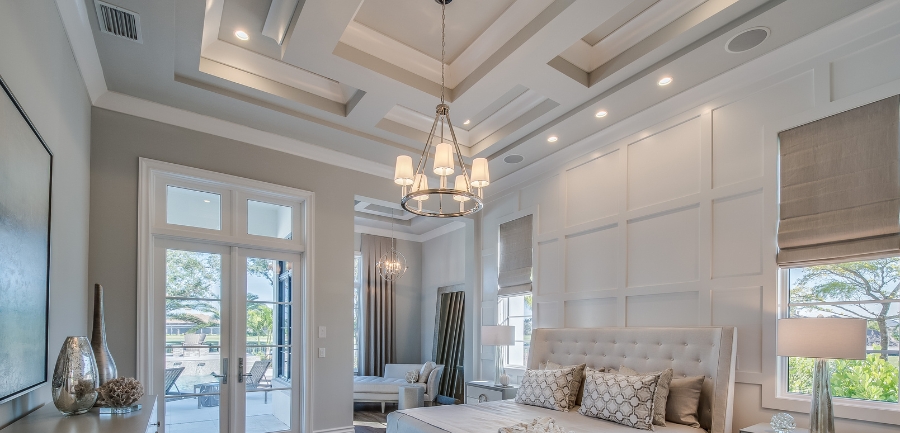
Embrace the future of ceiling design by incorporating unique, modern elements into your coffered ceiling. This could include innovative shapes for your coffers, bold color choices, or integrating smart lighting systems within the design. The key is to push traditional boundaries and create a ceiling that is not only aesthetically pleasing but also reflects your individuality and forward-thinking style. A new, contemporary ceiling design can transform your space into a showcase of modern elegance.
Ceiling Panel Ideas

For a dynamic, versatile look, consider the use of ceiling panels within your coffered design. Panels can be chosen to contrast or complement your beams, creating a unique visual interplay. Opt for decorative panels with carved designs for a classic, ornate feel, or go for sleek, smooth panels for a modern appeal. They can be painted, stained, or even upholstered to match your room’s decor. Ceiling panels can add a layer of texture and depth to your coffered ceiling, enhancing its aesthetic impact.
Modern Drop Ceiling Ideas in the Office

Consider redefining your office space with a modern drop-coffered ceiling. This design can help to conceal ductwork, wiring, and lighting systems while adding a stylish aesthetic appeal. You can opt for a sleek grid pattern with metallic finishes for a contemporary look, or use wood or painted panels for a softer, more welcoming feel. Incorporate recessed lighting within the coffers for efficient, workspace-friendly illumination. A modern drop-coffered ceiling can transform your office into a stylish, functional, and inspiring workspace.
Wood Ceiling Ideas with Low Beams
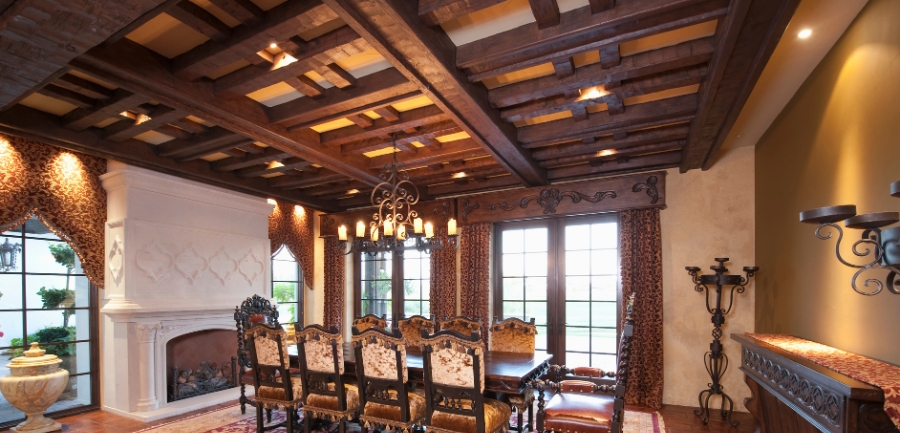
Envision a space that combines the cozy charm of wooden finishes with the architectural interest of coffered ceilings featuring low beams. This design can work wonderfully in rooms with a lower ceiling height. Opt for light-colored wood or paint finishes to keep the space from feeling too enclosed. The low beams can create a distinctive pattern without overwhelming the room, while the wood finish can add warmth and natural appeal. This design beautifully balances the elegance of coffered ceilings with the comforting ambiance of wood, creating a cozy and visually intriguing space.
Bedroom Ceiling Ideas

Imagine turning your bedroom into a tranquil retreat with a stunning coffered ceiling. Opt for soft, calming colors to enhance the peaceful ambiance of the room. You could also consider integrating ambient lighting within the coffers for a warm, soothing glow. For a touch of opulence, consider adding a statement chandelier or pendant light at the center. A coffered ceiling in your bedroom can add a luxurious touch, transforming the room into your very own peaceful sanctuary.
Ceiling Beam Ideas in the Living Room

Think about transforming your living room with the addition of ceiling beams in your coffered design. Be it rustic wooden beams for a country-style feel, painted beams for a modern look, or ornately carved ones for a classic appeal – the options are plentiful. The beams can be used to create a grid-like pattern or even a more unconventional design based on your personal preference. Incorporating ceiling beams can add depth and character to your living room, making it a captivating space for relaxation and entertainment.
FAQs
What is the purpose of a coffered ceiling?
Coffered ceilings serve dual purposes. They not only enhance the aesthetic appeal of a room but also improve its acoustics by minimizing echo and noise, especially in large spaces.
What are coffered ceilings called?
Apart from being referred to as coffered, these ceilings are often termed ‘lacunar ceilings’—a Latin term meaning ‘hollowed out’, which describes their characteristic recessed, boxed pattern.
Are coffered ceilings still in?
Absolutely, coffered ceilings are very much in vogue. Their timeless elegance and versatility make them a popular choice among homeowners looking to inject a dose of sophistication into their living spaces.
Are coffered ceilings expensive?
Yes, installing a coffered ceiling can be more expensive than a conventional flat ceiling due to the additional materials and labor involved. However, the value they add to your home in terms of enhanced aesthetics and potential property value often makes this a worthwhile investment.
To Wrap It Up!
Coffered ceilings, with their rich history and enduring appeal, truly stand as a testament to the transformative power of architectural design. Regardless of your preferred style – be it traditional, contemporary, or something uniquely personal – there’s a coffered ceiling waiting to enhance your space. Remember, while the initial investment may be higher, the undeniable touch of elegance, the improved acoustics, and the potential increase in your property’s value make them a worthwhile consideration. From the kitchen to the bathroom, the living room to the bedroom, coffered ceilings can be the crowning glory of any room in your home. Here’s to creating spaces that inspire and enchant!

